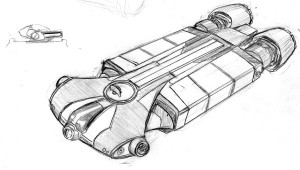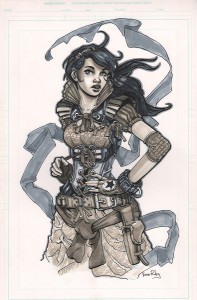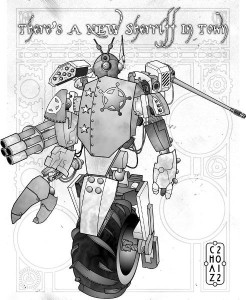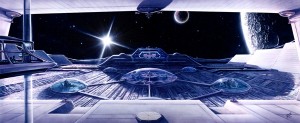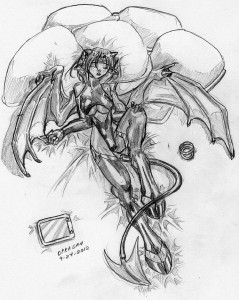Kalijor RPG
Kalijor RPG is a complete role-playing game to be published by Kalijor Press.
By Paul Lell
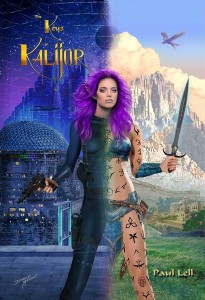
Learn more about Kalijor here
Back the IndieGoGo campaign here
Welcome to the forty-seventh Designer’s Diary, a column where designers are given the opportunity to take readers on an in-depth ride through the design and development process of their system, setting, or product. If you’d like to share your product in the Designer’s Diary column, send a message to aaron@roleplayerschronicle.com.
Designer’s Description
The Short Version:
The human race has moved out among the planets to escape a devastated Earth. Massive corporations control every aspect of life. While nobody who is willing to play by the rules will go hungry or without a home, there are those who strive to take back their independence from the corporate Conglomerate. Their battles to determine the fate of the human race take place in the real world, in cyber-space, and in the virtual world of Kalijor, a massively multiplayer online RPG that has become a hub of commerce and communication for a humanity spread out across the stars.
The Short, Short Version:
Firefly meets Middle Earth via the Matrix
The setting is one in which three different worlds and styles of play can be merged together, or enjoyed on their own. With players able to take part in space sci-fi gaming with space ship battles, cybernetics, genetic engineering, and even psionic abilities that grant characters super hero-like powers. Or they can play in the high-fantasy world of Kalijor with dragons, elves, dwarves, swords, and sorcery. But it isn’t a typical world with classic tropes. Rather, it is a world invented by humanity, and built by game designers, so while some of it harkens back to the stories of Earth’s past, much of it is new and unfamiliar.
Then there is the space between Kalijor and the real world. A cyber-space constructed on the network that connects all the cities, stations, and ships that keep humanity alive in the harsh climes of the solar system’s myriad worlds. In cyber-space, the programmer’s imagination is the only limit to the shape of the virtual world around them, and those that enter their domains to take valuable information must contend with the might of their computer skills. Players can ‘Net-Dive’ into cyber-space, mentally entering the virtual world, much as they do Kalijor, but here, their skills with computers allow them to manipulate reality around themselves, conjuring up weapons, armor, and mirror images of themselves to try and defeat their adversaries.
More info can be found at the IndieGoGo campaign here: http://www.indiegogo.com/projects/kalijor-a-role-playing-game-for-all-ages
The Kalijor RPG is designed from concept to execution to be a different sort of animal from your average RPG. We’ve worked hard to incorporate as many of the best ideas from other game systems as we could, while at the same time keeping things as flat and streamlined as possible. I, personally, enjoy a much more story oriented style of game play, and the system reflects this fact in that it takes a little longer to make characters than, say D&D, but they also turn out a bit tougher, better able to make it through their first few levels and get into some real character development.
We’ve even gone so far as to make the system playable with or without the use of dice. This allows players wishing to play a more traditional game system to do so, rolling dice to add that element of chance and the possibilities for critical success and failure, while those looking for a much more story-telling style of game play can avoid the dice and use skill ranks to determine success and failure of actions.
Additionally, the system was built in such a way as to be able to peel out certain layers of logistics and mechanics, simplifying the game to the point that, with some parental assistance, children as young as 4-7 years old can play. We’ve used this layering to create three distinct tiers, each of which will get its own core rules book, and each one representing a different ‘level’ or age range of players. One for kids 4-7 with their parents’ help, one for kids 7-14 that is still fun for the whole family, and one that is the full-featured game for folks 14 and up.
Our intent with all of this is to not only provide a great, story-rich world for gamers to explore and build their own tales of daring-do in, but also to help raise the next generation of gamers by allowing gamer parents to involve their children in an activity that both entertains and teaches useful skills. Skills such as number recognition, primary color recognition (using sets of dice designed for younger kids), basic addition, subtraction, and multiplication. And as most gamers can attest, playing tabletop RPGs also teaches some more esoteric, but still mind-bogglingly, useful skills such as critical thinking, creative problem solving (thinking outside the proverbial box), and teamwork/facilitation skills.
On a personal level, I’m sure most folks reading this article will have had much the same experience growing up. I’ve been reading voraciously since I was knee high to a Brownie. Everything from Tolkien to Melville, and Adams to Asimov. I’ve played so many different RPGs that I couldn’t begin to name them all, and I have become something of a story teller through my writing, as well as my Game Mastering.
I’m the person that can sit through almost any film as long as the writing is good and the characterization is in any way worthwhile. My writing influences range all over as well, but in the last few years I have been able to actually meet and hang out with many of them, mostly due to my continued efforts to raise awareness of my novels. Spending time with folks like Kevin J. Anderson, Timothy Zahn, Peter Wacks, Kevin Siembieda, and so on. They’ve all helped me become a better writer, world builder, and self-promoter. They’re all personal heroes of mine, and the fact that they have made themselves so available to fans and willing to talk about the art and craft of writing and game design has been a great boon to me in my own efforts.
In terms of influences on the game and the world it takes place in, my influences can probably be traced back through the years to several dozen different sources. It is high fantasy, space opera, steam punk, and virtual reality all rolled into one world. Not just the game system, but indeed the entire setting is designed to allow players to decide what kind of game they want to play, and then play it. Using nothing but the core book, they can play a high fantasy campaign with ‘traditional’ races, magic, dragons, the works. Or, they can choose to play a sci-fi game with smugglers, rebels, an oppressive corporate regime to rail against and a populace filled with genetically and cybernetically augmented people around every corner. If they are so inclined, they can also play across both genres, with characters in the sci-fi setting who also have avatars in the fantasy world. Since all currency and data is, for the most part, digital, it all rolls together into one ‘kitchen sink’ game that allows players to play however they like.
For me, research is a never-ending endeavor. I am constantly reading, both fiction and non-fiction, science news and accomplishments, politics, self-help, whatever I can get hold of. Usually, my research is driven by some aspect of whatever I am working on at that time, but really, I’ll just sit and read whatever is at hand when I have a moment.
I’ve had to play dozens of different games, both table top, and electronic, to learn how to accommodate all of the mechanics I wanted to include in the game, so there have been hours and hours of playing games involved. But that isn’t as fun as you might think. There’s a difference between playing a game to have fun, and playing a game to dissect every little aspect of how it works ‘under the hood’ as it were.
I once had a chat with Todd McFarlane and the subject of research and understanding of subject matter came up. He said that, as a comic book artist, one must not merely be an expert on anatomy and geometry. One must become an expert mechanic that when the villain crushes a car, all of the correct pieces come out. When one crashes through a wall, the rubble must be convincing. You don’t have to be expert enough to fool an auto mechanic, or a home builder, but you should do well enough that even they are not given reason to get hung up on it.
As an example, I had to learn how to calculate odds and probability to build this game. Because I didn’t want the standard 20% odds that a D20 offers, but I also wanted the system to be fairly simple and incorporate as little math during game play as possible. Similarly, I needed to know things such as the orbital period of all of the planets in the Sol system, how many moons they have, where their orbits are, what kinds of surfaces and resources they have, how long it takes to travel to them using today’s technology, and what that same technology is predicted to evolve into in the next hundred years or so.
Then, I have to take all of that and extrapolate/imagine what it will look like in a thousand years!
I have six different artists engaged for this project. They all have distinctly different styles, but they all have one thing in common (aside from being amazing artists): they all love science fiction and fantasy! For the ‘full’ game book, I am pushing for a very comic book style of line art for the interior, with bold lines and exaggerated anatomy that makes heroes and villains look so amazing on paper. One of my artists is building a 3D rendering system that he is using to create images of gear, weapons, and vehicles that he can get 2D output from, but at any angle or perspective. That means we can reuse all of those models to get more shots of those things for future books, graphic novels, whatever.
I have a guy that does a great job with anthropomorphized figures. He loves drawing people with wings, tentacles, claws, cloven feet and legs, whatever. Perfect for covering the section on genetic augmentations/alterations. Another is a killer with poses and technology, making him my go-to for cybernetics and scenes involving multiple people. My ultimate goal is to have an image on almost every page. Some large, some small, but all pertinent and engaging.
For the cover, I have David Magoun, the guy who has done the covers for all but my first novel doing a fully rendered/painted wrap-around cover that incorporates both the sci-fi and fantasy worlds of the book. His early work on it is amazing and I am really looking forward to seeing the final image! With the younger versions of the game book, I am using a more ‘anime’ style of illustration with full color character images and environments designed to interest minds that have been trained to follow those bright pixels on so many screens. As the game is designed to be picked up and played, so too is the art designed to draw them in close enough to pick up the book!
Gaming Experience
For folks picking up the Kalijor RPG, my hope is the experience is whatever it is they are trying to achieve. If they want an action packed, combat rich game, then the rules will accommodate. If they want a mellow, story and character driven campaign, then the rules will accommodate that as well. They can roll dice and add bonuses, or just tell the GM what rank their hacking skill is and they can hash out what happens.
Kids of almost any age can play, and learn to love the game as well. Indeed, as one of my tests for the mid-age book, I handed a manuscript to my two kids (one 14 and one 11), and they sat down with their friends, looked it over, picked characters and started to play. There were no questions at all and the only gaming experience any of them had was a few sessions with Palladium’s Robotech RPG.
While I know that trying to make a game that is everything to everybody is not only impossible, but a disaster waiting to happen, my intent with the Kalijor game system is to create a full-featured RPG with many of those elements that my gaming friends and I love, and make it enjoyable to play in a variety of styles, and by a variety of age groups. I know that not everyone will like it, but then, not everyone likes D&D either, right?
I’m really not the best person to make comparisons as I’m ~kind of~ close to the subject matter here. That said, I feel comfortable in giving some details about the game engine and letting readers draw their own comparisons.
Character creation, after selecting race and class, is done largely by the allocation of points from two pools: Attribute Points, and Character Development Points. Attribute points are used to raise attributes from their starting base as determined by race, and can be allocated however the player wishes, as long as when they’re done, their character meets the minimum requirements for their chosen class. There are six attributes, three physical and three mental, and the mechanics make it so that mentally powerful characters can go toe to toe with physically powerful characters, as long as they do so in an intelligent way.
With Character Development Points, the player can select their skills and abilities or spells, depending on which setting they choose to play in. All skills, abilities, and spells work on a rank system, 1 through 5 and with the exception of some class skills, none may start higher than rank 2, or gain more than one rank per level of experience.
There is also an extensive system of genetics, cybernetics, and equipment that allow players to customize their characters by spending cash budgets both during character creation, and during game play.
Combat rolls are generally all opposed (one person rolls to attack and their target rolls to defend) and are made on 2D10 with 2 being a critical failure and 20 being a critical success. Damage rolls can be on any type or combination of dice both with and without multipliers, based upon the type of weapon or attack used.
Skill usage can be either opposed, when using a skill against someone else, such as in the case of two hackers going head to head in a computer system, or they can be made against a fixed number set by the game master based upon the difficulty of the task at hand. In either case, skill rolls are made as 1D10 per rank in the skill.
Outside of those basics, the game is pretty standard fare, I suppose.
On the subject of diceless play, it’s more about comparing the rank of characters’ skills against one another, or against the difficulty of the task at hand and then cooperatively resolving the situation through conversation and storytelling. For the younger versions of the game, some mechanics are pulled out, such as adding bonuses to die rolls and tracking ammunition and range of weapons and so on.
To begin with, I have to say that I originally wrote the Kalijor RPG using another system’s rules. My original intent was to either get the Intellectual Property licensed out to them, or to secure the IP rights to their game system and publish the game myself. I’m not going to mention the name of this other company just to keep everything on the level, but I do want to say that there was no falling out, and we are, in fact, still on very good, speaking terms. The truth is that it just wasn’t the right deal for either of us to make at the time, so we decided to go our separate ways.
That said, I ended up ‘taking the entire line back to formula’, as it were. The nice thing about that is starting from scratch afforded me the opportunity to do a few things I could not have done otherwise. To begin with, there was the use of a D20 for combat and contested rolls. I wanted the system to be, at its heart, very character driven. I wanted the player’s choices for skills, attributes, and equipment/modifications to be as much, or more, important during game play than that one in twenty chance.
It took some tinkering, but eventually I decided on using 2D10. It offers almost the same range of numbers, but increases the actual possible outcomes to 56, and normalizes results toward the middle. This means that critical success, and failures, are much more rare, and the player’s choice of skills, attributes, and modifications become very significant whenever dice are rolled to determine outcomes.
Once we had that mechanic in place, attention was given to skills and abilities, with special care taken to account for playing without dice. There was a lot of back and forth about how to make it happen, but after a few months of play testing and loads of tweaking, rewriting, and starting from scratch, we arrived at the rank system that the game engine uses now. We tried percentiles, classifications, ladders and frameworks, and half a dozen other arrangements. The Ranking system allows for rolls against static difficulty numbers, contested rolls against other characters, and resolution of skills without using dice.
The nice thing about having already written the game for another rule system is that 90% of the content itself was already written. The bad thing about having already written the game for another rule system is that 90% of the content itself was already written. I had to sort through the material several dozen times to pull out all of the artifacts of the old system. I’ve had dozens of sets of eyes combing over the material looking for relics and artifacts to get it all cleaned up.
Play testing has been a massive effort across a dozen groups with feedback pouring in for the better part of two years. At first, the feedback was about broken mechanics and skewed figures, but as time went on it slowly turned into missing commas and adjustments to formatting. Now, the game engine and material are getting high praise and new players are able to build characters without asking for direction.
Building a game engine from scratch was something I jumped into, thinking it wouldn’t be too difficult, especially as I’d been playing games nearly my entire life. It has been a very interesting endeavor and I am very excited to get it out there for the world to see and use. But it has been a lot of work, with a great deal of repetition and focused testing. I have never played the same scenario over and over again so many times that I thought I might get sick before. But now I have. And, to be honest, I’ve loved every minute of it.

